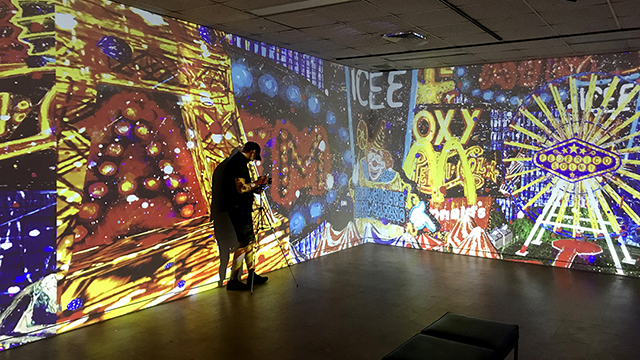Past and present, history and amusement, reality and spectacle are conflated and distorted in Federico Solmi’s monumental media work, “The Great Farce” (2017), recently acquired by Northwestern University’s Block Museum of Art. The Block received the multiscreen, limited-edition work as a gift from the artist’s studio in recognition of the museum’s upcoming 40th anniversary and its related initiative “Thinking about History.”
Originally commissioned for the 2017 B3 Biennial of the Moving Image, Frankfurt, Germany, “The Great Farce” is Solmi’s most ambitious work to date in terms of technical complexity, physical scale and scope of content. Featuring a cast of time-traveling world leaders with a feverish madness for power, Solmi’s animation turns a frenzied, fun-house mirror to grandstanding historical figures.
“‘The Great Farce’ presents a sprawling send-up of empire building as an enterprise, and a scathing commentary on contemporary culture where spectacle and celebrity may be distractions from more sinister machinations, and where the speed of things contributes to the blurring of myth and truth,” said Janet Dees, The Block Museum Steven and Lisa Tananbaum Curator of Modern and Contemporary Art, who has a longstanding professional relationship with the artist and his work.
“We are grateful to Solmi for recognizing The Block Museum’s teaching and learning mission by choosing its collection as a home for this work. ‘The Great Farce’ will be regularly activated at The Block, as our students and audiences join us in interrogating the narratives and construction of history,” Dees said.
In the nine-channel installation, painting, drawing and motion-capture images are stitched together using digital technology to create a surreal universe. The work can be presented as an immersive gallery installation with nine projections, or a sculptural “portable theater” with embedded video that represents the content, spirit and aesthetic of the larger installation.
“The Great Farce” was first exhibited on the façade of the Schauspiel Opera Theater in Frankfurt Germany, and later adapted into a gallery installation for Open Spaces Kansas City (2018). “American Circus,” a work adapted from “The Great Farce,” was displayed across multiple electronic billboards in New York’s Times Square in July 2019 as a project of Times Square Arts. (View a video of the making of “The Great Farce.”)
Thinking about history
The “portable theater” version of “The Great Farce” will be on view at The Block Museum of Art in the fall of 2020, when the museum launches “Thinking About History,” an exhibition marking the museum’s 40th anniversary. The collection-based exhibition and companion publication will reflect recent acquisitions that advance the museum’s interdisciplinary teaching mission and engage an increasingly global and diverse student body and broader public.
“Thinking about History” will consider the ways that artworks, and the museums that house them, serve a unique role in shaping our understanding of history. Presenting 100 artworks from The Block’s permanent collection, the exhibition will feature a wide-ranging selection of artists such as Dawoud Bey, Omar Victor Diop, Shan Goshorn, the Guerrilla Girls, Louise Lawler, Kerry James Marshall, Catherine Opie, Elle Pérez, Man Ray, Edward Steichen and Kara Walker, among others. The exhibition selections will focus upon the ways in which artists infuse their work with critical observations that connect past and present.
“Irreverent, beautiful and complex, ‘The Great Farce’ is among the most compelling works The Block has recently acquired as part of its ‘Thinking About History’ initiative,” said Lisa Corrin, The Block’s Ellen Philips Katz Director.
“Housed within the museum’s active and interdisciplinary teaching collection, the work has the potential to spark critical debate about the relationship between history and myth as well as the benefits and challenges of satire,” Corrin said. “Solmi’s animated take on the politics of power interrogates the strategy of history-making that is embedded in artworks. We are honored to work with the artist to bring ‘The Great Farce’ to Northwestern and Chicago.”
The large-scale installation version of “The Great Farce” will be presented at The Block Museum at a later date.
About Federico Solmi
Since 2004, Italian-born, American artist Federico Solmi has created increasingly complex works that combine drawing, painting and video animation. He employs extreme satire to critique the corruption of figures of power across cultural, financial, governmental and religious institutions. Solmi is recipient of a 2009 fellowship from the Guggenheim Foundation. His work has been presented in screenings, festivals, solo and group exhibitions at several international venues including “The Dissolve,” the 8th SITE Santa Fe Biennial (2010), the 54th Venice Biennale (2011), the 7th Berlin Biennale (2012) and Frankfurt B3 Biennial of the Moving Image (2017).
The artist’s solo exhibition “Federico Solmi: The Grand Masquerade” is currently on view through Oct. 6, at the Tarble Arts Center at Eastern Illinois University. The artist’s work also will be included in the Smithsonian National Portrait Gallery’s “American Portraiture Today,” Oct. 26, 2019 to Aug. 30, 2020. Solmi is currently a visiting professor at Yale University School of Art, New Haven, Conn., and is represented by Ronald Feldman Gallery, New York, and Luis De Jesus, Los Angeles.
About The Block Museum of Art
Northwestern University’s Block Museum of Art is a dynamic, imaginative and innovative teaching and learning resource for the University and its surrounding communities, featuring a global exhibition program that crosses time periods and cultures and serves as a springboard for thought-provoking discussions relevant to our lives today. Admission to the museum is always free and open to all.
The Solmi gift counts toward We Will. The Campaign for Northwestern. The funds raised through the “We Will” Campaign are helping realize the transformational vision set forth in Northwestern’s strategic plan and solidifying the University’s position among the world’s leading research universities. More information on We Will. The Campaign for Northwestern is available at wewill.northwestern.edu.


